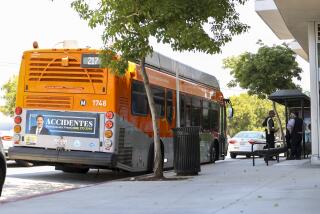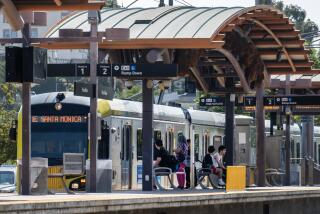Vibrant Bus Service in Santa Clarita Is Riding High
- Share via
In Santa Clarita, the car is still king. Nearly half of the workers in the city commute to jobs outside the area, many of them crowding the lanes of the Golden State Freeway, Santa Clarita’s lifeline to Los Angeles.
But the suburb of 150,000 also has developed a vibrant bus service. Santa Clarita Transit is logging nearly 3 million boardings a year. In the last five years, its ridership ballooned by 67%, making it one of the 10 fastest-growing systems in the country, according to the Washington-based American Public Transportation Assn.
And while the city runs popular long-haul commuter routes, more than 85% of the riders use the buses that travel within the Santa Clarita Valley, transit coordinator Bob Murphy said.
The bus system has grown in step with Santa Clarita’s population, which increased by 40,000 in the 1990s. Transit experts say the city, incorporated 15 years ago, has done a good job of meeting and even nurturing demand for the buses.
Last month, Santa Clarita opened a $2.5-million bus transfer station, which serves eight of the system’s 33 local and commuter routes. It is a block from the Valencia Town Center, the city’s main shopping area, a big draw for bus riders. The center is also home to office buildings housing businesses such as Princess Cruise Lines.
“They’re building [transit] strategically as they build a city,” said Jim de la Loza, executive officer for planning for the Metropolitan Transportation Authority. “This [station] is a good indication of that.”
The buses also serve Valencia Gateway Park, where about 40,000 people work.
“If the jobs exist at a discrete number of locations--at an office park and a defined downtown--it’s going to be easier to provide transit service to those areas,” said James Moore, a USC civil engineering professor and transit expert.
Like the Town Center, whose faux-Spanish roofs loom a block away, the new transfer station exhibits an immaculate orderliness that L.A. denizens might experience only on studio back lots. Buses navigate a wide, U-shaped boarding lot, while riders wait for transfers on stained wood benches under huge, kite-shaped canopies.
Riders like Peter Van Dyke--who was coming home from his job at the local hospital one recent day--say the station is a big improvement over the cramped old transfer point on the other side of the Town Center.
“It’s just nicer to be sitting in modern conveniences,” he said.
Santa Clarita has a large, bus-dependent working class. About 20% of its 47,000 families are considered lower income, making less than $41,000 a year, city planner Marika Modugno said.
The city’s buses also provide rides for 1,500 students in the William S. Hart Union School District, which scaled back its service after encountering budget problems.
With Santa Clarita expected to grow by 50,000 in the next two decades, officials like city transportation spokeswoman Gail Ortiz hope those students stick with buses.
“We’re hoping that this builds lifelong habits,” she said.
More to Read
Sign up for Essential California
The most important California stories and recommendations in your inbox every morning.
You may occasionally receive promotional content from the Los Angeles Times.













